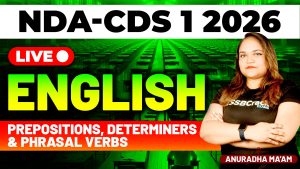As part of our dedicated preparation for the NDA-NA Exam, we recently delved into the topic of Matrices and Determinants in Paper I: Mathematics. This topic is fundamental to various areas of mathematics and is frequently tested in competitive exams. This article will highlight the key points discussed in the class, provide strategies for effective preparation, and share tips for excelling in this topic.
Understanding Matrices and Determinants
Matrices and determinants are powerful mathematical tools used to solve systems of linear equations, perform transformations, and analyze data. Understanding these concepts is crucial for the NDA-NA Exam.
Key Sub-Topics Covered:
- Matrix and Its Order:
- A matrix is a rectangular array of numbers arranged in rows and columns.
- The order of a matrix is defined by the number of rows and columns it contains.
- Types of Matrices:
- Various types of matrices include square matrices, row matrices, column matrices, zero matrices, and identity matrices.
- Each type has specific properties and applications.
- Operations on Matrices:
- Addition, subtraction, and multiplication of matrices.
- Understanding the rules and properties of these operations is essential.
- Transpose of a Matrix:
- The transpose of a matrix is obtained by swapping its rows and columns.
- Transpose plays a vital role in various matrix operations and properties.
- Symmetric and Skew-Symmetric Matrices:
- A matrix is symmetric if it is equal to its transpose.
- A matrix is skew-symmetric if it is equal to the negative of its transpose.
- Determinant:
- The determinant is a scalar value that can be computed from a square matrix.
- It is used to determine whether a matrix is invertible and to solve systems of linear equations.
- Properties of Determinants:
- Various properties, such as the effect of row operations on the determinant, are crucial for simplifying determinant calculations.
Strategies for Effective Preparation
1. Grasp the Basics
Before attempting to solve problems, ensure you have a strong understanding of the basic concepts. Know the definitions and properties of matrices and determinants. Understanding these basics will help in solving complex problems more efficiently.
2. Regular Practice
Regular practice is key to mastering matrices and determinants. Work on a variety of problems to familiarize yourself with different question types. This practice will help in improving both speed and accuracy.
3. Use Visual Aids
Visual aids, such as diagrams and illustrations, can be extremely helpful in understanding the structure and operations of matrices. These tools can make complex concepts easier to grasp and remember.
4. Solve Previous Year Papers
Solving previous year papers and sample questions is crucial for understanding the exam pattern and types of questions asked. This practice helps in identifying important topics and areas that need more focus.
5. Group Study and Discussions
Group study sessions can provide new insights and different approaches to solving problems. Discussing questions with peers makes learning more interactive and engaging, and helps in clarifying doubts.
6. Time Management
Time management is critical during the exam. Practice solving questions under timed conditions to simulate the actual exam environment. This will help in managing time effectively and ensure that you can solve all questions within the given time.
Discussing Important MCQs
In our class, we focused on discussing multiple-choice questions (MCQs) based on the topics covered. This approach helps in applying theoretical knowledge to practical problems, which is essential for the NDA-NA Exam.
Example MCQ 1: Matrix Types
Question: Identify the type of matrix for the given matrix A.
To solve this, you need to determine the properties of matrix A and classify it accordingly. Practicing such questions enhances your ability to quickly recognize different types of matrices.
Example MCQ 2: Determinant Calculation
Question: Find the determinant of the given matrix B.
Here, you need to use the definition and properties of determinants to find the solution. Practicing such questions ensures you can handle determinant-related problems efficiently.
Example MCQ 3: Matrix Operations
Question: Perform the specified operation on matrices C and D and find the result.
Such questions require you to use matrix operations, reinforcing your understanding of how to manipulate and calculate with matrices.
Conclusion
Mastering matrices and determinants is crucial for excelling in the Mathematics section of the NDA-NA Exam. Our class focused on understanding these concepts deeply and practicing essential MCQs to ensure we are well-prepared. By understanding the key sub-topics and employing effective preparation strategies, we can excel in this topic.
Regular practice, solving previous year papers, group study, and effective time management are essential steps towards achieving success in the NDA-NA Exam. With dedicated effort and a strategic approach, mastering matrices and determinants becomes an attainable goal, bringing us closer to acing the Mathematics section of the exam. This focused preparation will not only help in scoring well but also in building a strong foundation for other mathematical concepts.



















